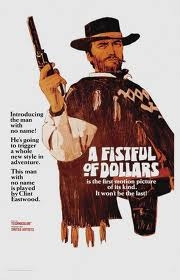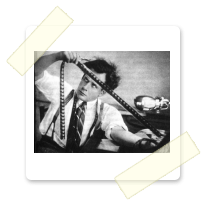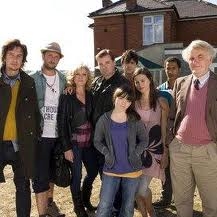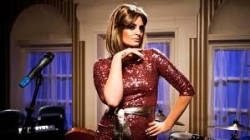Adam Windmill Interview
Adam Windmill is the editor of Channel 4 comedy Very Important People and Starlings for Sky 1. He has edited comedy and drama for some of the most prolific directors in the UK like Matt Lipsey and Steve Bendelack.
He first rose to prominence when he edited all three series of The League of Gentleman followed by The Mighty Boosh pilot, he has barely stopped since.
What can you tell us about the story of Starlings and the team behind it?
Starlings came along at just the right time. I’d been watching some great 60’s new wave films and thinking it would be nice to try my hand at some drama. It was commissioned by Sky Comedy so first and foremost it had to be funny but after my first meetings with director Matt Lipsey and Production Company Baby Cow it became clear that the drama side was equally important which made it very appealing.
If you haven’t seen the show it follows the lives of a working-class family living in Matlock, Derbyshire called the Starlings. I won’t talk too much about the principle cast as it’s been well publicised but I will say it was a great mix of comedic and dramatic actors which really reflected the scripts. Written by Steve Edge and Matt King we shot on location in Derbyshire, and at Wimbledon studios in two blocks over about 16 weeks. One block was directed by Matt Lipsey and the other by Tony Dow, I was editing with Matt and Robin Peters was editing with Tony. The producer was Ali MacPhail with Henry Normal, Steve Coogan and Lucy Lumsden (Sky) as execs.
I was editing on location in Matlock for the first three weeks of the shoot; the beginning of a shoot is always an interesting time as it’s when rushes start to arrive that you first meet your characters. Key scenes were saved until mid way through the shoot; this gave us some great performances as by this time the cast and crew were all very comfortable with each other. I remember during a birth scene (in which a real baby was used) I could really feel the tension and emotion in the rushes. As an editor it’s times like this that you feel a responsibility to make sure you get this through in your edits. I remember reading Italian director Bernardo Bertolucci was never a big fan of editors as he always felt they diluted the energy of his rushes by bringing order. His opinion did change after working with Venetian editor Franco Arcalli on The Conformist but this always stays on my mind. The emotion must be the driving force and sometimes at the cost of elegance in an edit, this also applies to comedy.
I think the original idea for Starlings was to make a funny show with a warm heart. So many things have to come together to do this successfully with the editing being only a small part. The show has had some great reviews and one I really liked said something along the lines of you’ll laugh and cry along with the Starlings family. This stood out for me as it was exactly what we set out to try and achieve.
You’ve recently completed work (at time of going to press) on Very Important People, a topical comedy-impression show on Channel 4. What’s been your biggest challenge on that show?
With Very Important People the rough cuts or assemblies were a big challenge. I cut scenes together while the show is still being shot and this has several benefits: any technical problems can be quickly highlighted; shots that may need to be picked up can be flagged early, and during the shoot the director/producer are able to see completed sketches which can help with creative decisions. With Very Important People some sketches needed to be cut from the shoot and the decisions were made on the strength of these rough cuts. This meant that all the rough cuts had to be seen in the best light so all had to be finished to a high standard in a short time.
Another challenge was the topical inserts. As we were editing to transmission we could react to audience opinion, as our topical inserts were funny and proved to be very popular they grew in scale week on week. There were two weeks that I only had half a day to cut a music video. Many years ago I used to work as an edit assistant on Spitting Image and every show would have a song. These would usually be shot and cut in advance as they can be very time consuming to get right in the edit. Modern work-flows and non linear editing have made our lives a lot easier but it was still a challenge.
What got you interested in Editing and how did you start out you career?
I started as a runner at a small company (now sadly gone) called TWTV which was in Kingly Street, W1. It was actually a small editing company but at the time I wasn’t really sure what I wanted to do. I knew I loved films but wasn’t really sure where I wanted to try and make my contribution. I worked there for about eighteen months before leaving to start work at a much larger company called Virgin Television. There I worked on a rotating shift and got to try lots of different things including live studio work, transmission, edit assisting, dubbing, and a dreaded night shift. Virgin Television transmitted Super Channel (an old satellite channel) which would to close down for four hours each night between about two and six am. It would take about an hour to load all the tapes and get everything ready for the start of each day’s transmission, so every night there would be about three hours of down-time to fill. Virgin Television also made programmes for satellite channel Music Box, which was a bit like MTV, so there was a library full of music videos in the basement. Forty of these could be loaded into a machine called a Betacart that could play then all out seamlessly onto a VHS tape if programmed correctly; as long as everything was back in place for the six am transmission start no harm was done. Music has always been a passion so learning to programme that complicated Betacart machine was a priority.
Another nice memory from my Virgin Television days was film duplication. They had a contract to create 1-inch masters for VHS duplication for a company called C.I.C. When shifted to do that work I’d spend entire days just watching and copying films.
It was actually at Virgin TV that I made my mind up that I wanted to be an editor and much as I enjoyed it there I had to leave because the way the shift system worked I could only spend about one week in five assisting in the edit suites. I went to work at The Moving Picture Company and that’s where my enthusiasm for editing really grew. They were creating some of the best work in the world and I was working with some of the best people in the world. I owe the early 90’s editors at MPC a great deal as it was there openness, and enthusiasm that allowed me to learn so much.
My next move was to a small company that had just invested in two new state-of-the-art on-line edit suites called Framestore which at the time had fast growing a reputation for very creative work. An editor called Martin Hicks, who I’d worked a lot with, had been poached from MPC to work in the new suites. He asked me if I’d like to join him and it was an offer that I gladly accepted. After a year or so of assisting it was there that I started editing and many years just seemed to fly by. It was also at Framestore that I made the transition from on-line/VFX editing to off-line (Avid) editing. Avid released a new version of its non-linear editor which for the first time included a chroma-keyer, this enticed Framestore to buy one as they now saw it as a great offline tool for complicated VFX work. Framestore always kept one or two Avids running and I would try and get on them whenever I could. It was only in 2007 that I made the jump to go freelance as an editor so I could concentrate on off-lining full time.
You worked on every series of The League of Gentlemen. The writers of the show drew from a wide range of horror, how important was researching those films?
The League of Gentlemen are so organised and professional. Even for the first series they had a large collection film and TV clips that had inspired them. These were compiled onto a DVD which was used as reference for the series. This was a great starting point and with the help of Steve Bendelack (director) and Jemma Rodgers (producer) the mood and style of the show was formed. I know there are still references in the series for me to discover and every now and then I’m watching a film and hear a line delivered in a way that I think I’ve heard somewhere before. We knew we were working on something groundbreaking and with beautiful shots from Steve and great performances from The League, series one and two were surprisingly straightforward to put together. The third series was more complicated as all the episodes ran parallel but each week from a different characters perspective. When you realise we didn’t use any split screens and all the characters were only played by three people (so only certain characters could appear on screen together) it makes the writing and directing achievement even more amazing.
I’m sure I still have a copy of the original forty something minute pilot somewhere at home and I don’t think it’s ever really been seen. It’s essentially an extended first episode but as the pilot was non TX we didn’t have to conform to any duration; it’s probably about ten minutes longer than the original Episode 1. We tried several times to get it onto a series DVD release but as the League DVD’s were always so full of extras there just wasn’t space.
After The League of Gentleman, you then went on to work on another very distinctive comedy with The Mighty Boosh. Another cult hit, how did you approach that very unique brand of comedy?
The Mighty Boosh was also directed by Steve Bendelack and was a different challenge; I didn’t edit the series but I did cut the pilot. The League would polish their scripts and give very consistent performances but The Boosh would be at their best when sparring. There was of course a script but every take would be different. There was always a lot of energy and movement in Noel and Julian’s performances so from take to take they were very rarely in the same place at the same time. My job was basically to join the funniest bits together in as fluid a way as possible. I remember reading in an editor’s biography that film is flexible so bend it into any shape you want. I think this is true and there is always a way to make something work; you may not see it straight away but just have to be patient and persistent.
During that period, you also cut shows like Garth Marenghi’s Dark Place and pilots for Fur TV and Alison Jackson’s Double Take. Each one very different from the last – are there any favourite moments from those shows?
Garth Marenghi’s Dark Place was definitely a career highlight as I loved everything about the show. It was also the first time I worked with Richard Ayoade who is a director I have great respect for. My memory of Garth Marenghi’s Dark Place is long hours and laughter. Later I found out the production team were under quite a lot of pressure from Channel 4 as it was a very expensive show (for its time) but In the edit you’re protected from a lot of the politics and it didn’t feel like it at all. I remember laughing a lot in the edit and hearing laughter all over the rushes before and after takes. I think the atmosphere on location really made it through to the rushes and shooting on film made it feel even more special; I still really enjoy watching Dark Place.
You also cut commercials for the likes of Steve Bendelack. What do you enjoy about the different challenge of the short form edit? Do you get more time?
I’ve worked a lot with Steve Bendelack and he’s another director I greatly admire. Steve has a great reputation for comedy but I know he could put his hand to any genre and get a great result.
With a commercial you only have a short screen time so it’s crucial to make sure every frame earns its place. When used to sell, humour is a good vehicle but it’s important not to squeeze too much in; rhythm and timing are so important, it’s always tempting to try and get another joke in but it could be one too many.
Finishing is another difference, with a commercial you can look at every single shot and think how could I make that better. This can be as simple as replacing a sky or as complicated as creating the shot from four or five different takes and compositing all the best elements together.
Having the budget to try new technologies is another commercial luxury. When the Arri Alexa camera was released there were only a few in the country and a short-form production is more likely to be able to get hold of one for a few days. Also when CGI or complex compositing is needed it’s great to be at one of the premier post companies to see what can be achieved. This knowledge is good as these technologies always filter down and will affect future work-flows in long-form projects.
As an established and successful editor, what advice would you give your younger self?
I think I would tell myself to be patient and not to rush. Once I’d decided to try and become and editor I was in a hurry to start assisting, to start editing, and then to learn about the rules and craft of editing, but understanding emotions is such an important part of the job and that just comes with life. Patients in the edit is also important; there’s a part of me that always wants to jump in and start cutting but it’s wiser to give your thoughts time to shape before jumping in.
From a technical point of view, what do you edit with and what developments have made the biggest differences to your craft?
I’ve always cut on Avid and although I’ve taught myself Final Cut Pro a few times I’ve so rarely been asked to use it that I always forget. I was a little sad to see Apple starting to withdraw FCP from the professional market as I think editors actually benefit from competing systems; FCP made Avid improve and become a lot more proactive.
Non linear editing has made the biggest impact to my generation of editors but last year I worked on a stereoscopic (3D) drama which I think opens a door to a new way of storytelling and playing with emotions.
If you could change one thing about the industry, what would you do?
I’d love to reverse what I think is a decline in stereoscopic (3D) productions. I think 2D still has its place as does black and white imagery but when done well 3D can bring so much to a film. In films like Hugo and Prometheus I can and see how the technique is evolving and being polished. It will be a shame if this new wave of 3D stops just as it’s finding its feet. It’s never been easier to shoot stereoscopic imagery and it’s a great chance for us to pioneer new film grammar in production and post production.
What do you do when you are not working?
When I’m working the rest of my life seems to shut down a bit as editing almost always involves long hours. So when not working I really just enjoy normal things. Music is a big passion and I have a large collection, I love discovering new records and have done a little writing for a New York based music magazine called Wax Poetics. I enjoy exotic trips but also simple last minute camping weekends to escape the city and last but not least I love watching films, but always seem to buy more than I have time to see.
 If you could have worked on any project or with any director, what would you choose?
If you could have worked on any project or with any director, what would you choose?
I’d love to work on a big 3D film as the pioneering aspect of it really appeals to me; I think it would be a massive learning curve both creatively and technically.
If I could go back in time though I’d loved to have worked with Sergio Leone and I wouldn’t be fussy about which one on one of his Spaghetti Westerns I was involved in. I’ve watched those films so many times and just thinking about them brings a smile to my face. I’ve managed to see The Good, the Bad and the Ugly and Once Upon a Time in the West on the big screen which was a great experience; the other two I’m still waiting to appear in a cinema. There are films like Godard’s Breathless that have pushed the craft of editing forward and these would also have been exciting to be involved with but the Spaghetti Westerns I just loved before I know anything about film making so it’s all from the heart.
Adam Windmill (GBFTE) is a member of thecallsheet.co.uk and you can view his profile page here.
thecallsheet.co.uk is the members only network for those working in Film, TV, commercials and promos in the UK. Membership is free and services include a chase list, jobs board, online diary service, interviews, discounts, downloads, forums, glossary and more... with our database of over 6000 productions and with over 1200 members, we make it easy to search for the best crew in the UK.
Are you on thecallsheet.co.uk? join here



Comments